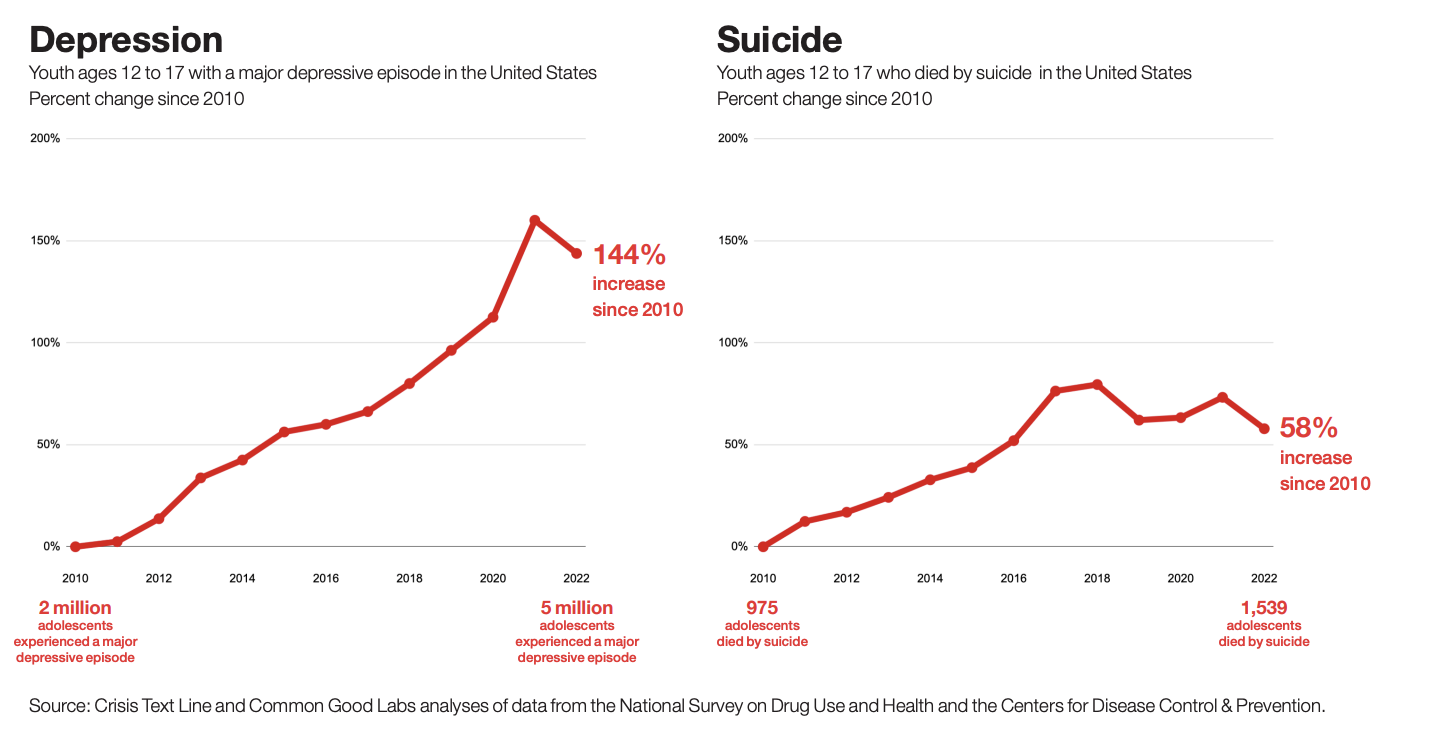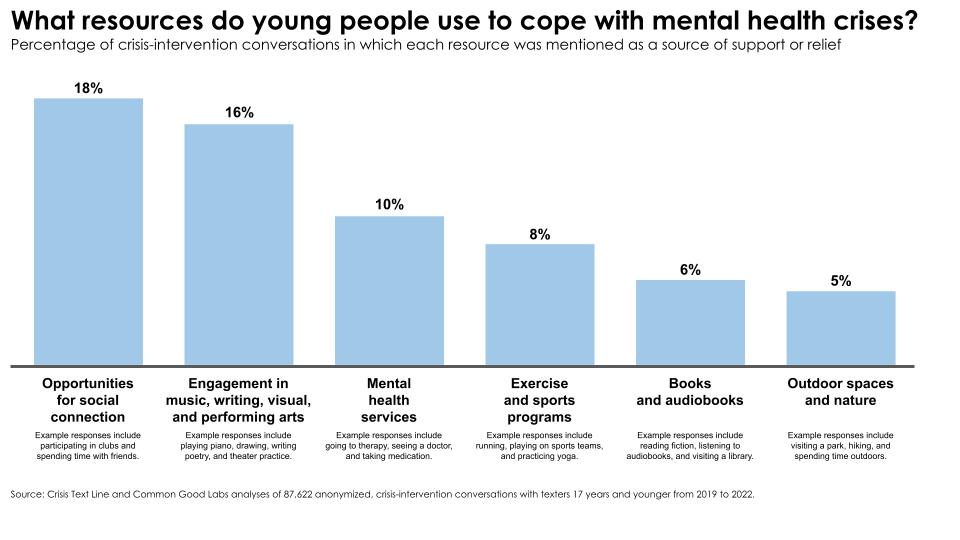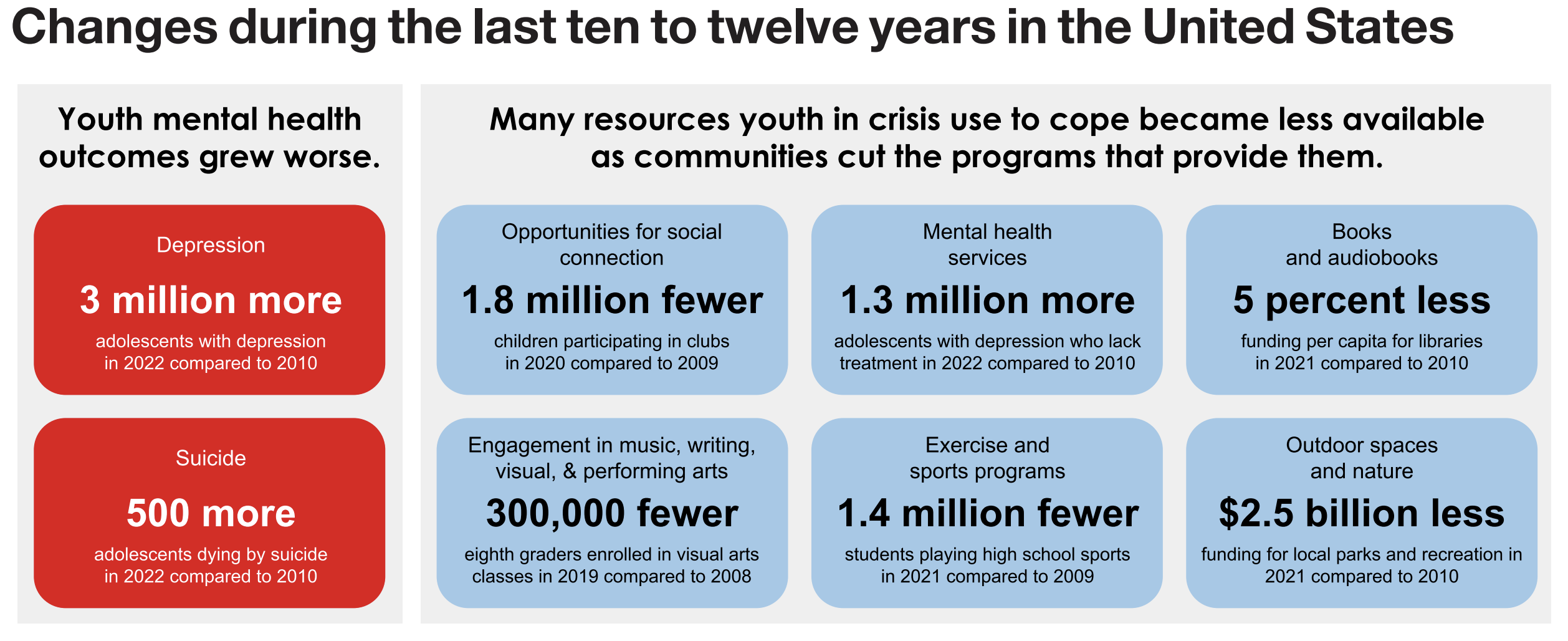Six things adolescents need from their communities to face the epidemic of depression and suicide
A new report from Crisis Text Line and Common Good Labs uses data science to provide solutions to the teen mental health crisis in the United States.
Young people in the United States are battling a mental health epidemic. Many of them are sad and hopeless. There are 3 million more adolescents with severe depressive episodes than a decade ago. Though depression and suicides fell in 2022, both are still far above the levels seen twelve years earlier.
Suicides have grown in communities across every geographic region in the United States. These increases can be seen in more rural states, such as Alabama and Idaho, as well as those that are primarily urban, like California and New York.

Many experts agree that there is a connection between these increases and the rise of new challenges facing youth, such as social media, mass shootings, and opioid use. Unfortunately, none of these challenges are likely to change in the near future. Communities need to find solutions to protect youth mental health.
To find solutions, we need to listen to young people.
Crisis Text Line is in a unique position to listen to what young people need, because we talk to hundreds of thousands of young people in crisis every year. Not only about their crises, but also about the things that help them cope.
So, we partnered with Common Good Labs to analyze over 87,000 anonymized conversations where young people mentioned coping resources and paired it with public data access to these resources. Here is what we learned.
1. Adolescents mentioned six resources they need from their communities to cope with crises.
- Opportunities for social connection;
- Engagement in music, writing, visual, and performing arts;
- Mental health services;
- Exercise and sports programming;
- Books and audiobooks; and
- Outdoor spaces and nature, including walkable neighborhoods.

2. Unfortunately, communities have been cutting programs that provide the resources youth in crisis need.
In the years following the 2008 Financial Crisis, many local governments reduced funding for programs that were deemed less essential. Several of the coping resources that young people need have never recovered from these budget cuts. Measuring high school sports and extra-curricular opportunities for social connection is difficult at the national level, but participation in these activities has declined significantly — even though there are more young people today than a decade ago.
The chart below summarizes the declining participation and budget cuts that these resources suffered over the past decade.

3. Many young people now lack access to community resources that support their mental health.
As a result of the budget cuts mentioned above, many young people now lack access to community resources that support their mental health.
The results are striking.
- Seven in ten children do not participate in clubs.
- Five in ten adolescents with depression do not receive treatment.
- Five in ten high schoolers do not play sports.
- Four in ten children do not live near a library.
When young people struggle with mental health distress, large numbers of them do not have access to resources that can help them cope.
4. Access to these resources highly depends on where young people live.
Access to the six resources young people use to cope with mental health crises varies enormously depending on where they live. An example of this can be seen in data on access to mental health professionals in counties across the United States. Over 32 million children live in a mental health shortage area.
As the map below illustrates, this varies significantly county-by-county — with adjacent jurisdictions sometimes having dramatically different levels of access.

As the map makes clear, rural areas are particularly affected by the lack of mental health providers. Among rural counties, an average of nearly 90 percent of children are in mental health shortage areas, compared to around 60 percent of children for counties in metropolitan areas.
Communities should reinvest in the resources young people need
Our report has found that over the past decade, as young people faced increasing stressors, many communities cut access to programs that provide resources to help them cope. We believe that community leaders should reframe the way they think about mental health support for youth. Extracurricular clubs, arts education, sports activities, libraries, and outdoor spaces are important services and programs for supporting young people’s mental health — in addition to the intrinsic value that each brings to local communities.
Young people are dealing with a crisis. Adults should come together to protect the coping resources they need the most to face the challenges to their mental health.
With questions on methodology, please contact research@crisistextline.org
With press requests, please email press@crisistextline.org
